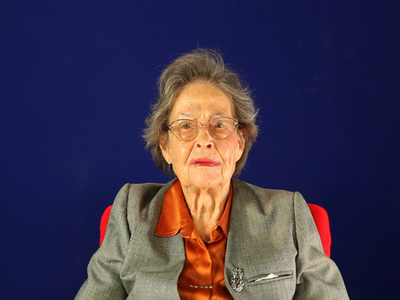Reverb: New Art From Greece
The Alzheimer-stricken Greek woman stares down from a large screen on the wall. Her personal narration is interspersed with flashed images: Mickey Mouse, Soviet Nazis, gunfire. Over the grandmother’s muted words runs the sound of a newsreel, spewing information from a 1970s broadcast on Greek National Television. You can’t follow both storylines. Loukia Alavanou’s striking piece begs the question, which will you listen to?
Alavanou is one of nine Greek artists featured in the School of the Museum of Fine Arts show Reverb: New Art From Greece. The exhibit’s goal is not to be an overview of contemporary Greek art but to reveal alternate perspectives of the many changes in the country. A new sense of urgency has infused into the artwork as a result of the social and political turmoil the Mediterranean country has experienced in the past 20 years. The two curators, Eirene Efstathiou and Evita Tsokanta stated, “We were interested in presenting this local view beyond the stereotypes and news images that people are accustomed to seeing.”
Efstathiou is an SMFA alumna and described her process of curating the exhibit as a kind of homecoming. “We thought it contextualized the whole show for the community of the school in a more personal way,” she said. Two of Efstathiou’s own works are included.
The exhibit tightens the lens on Greek art, bringing the viewer right into the homes of the artists, “presenting the dominant forms and patterns that illustrate the way an artist senses the reverberations of social, political and economic conditions and ultimately the shifting cultural landscape that documents reconsiderations of the notion of identity in Greece now,” said Tsokanta.
Many of the works are deeply personal, giving a human face to contemporary Greece rather than a headline story. Ore Bounce by Dimitris Papoutsakis combines the refuse from mining activities in Nothern Evia with a digitally processed version of the artist’s own heartbeat. As you circle around the speaker full of magnesite dust, Papoutsakis’s heartbeat pulses around you. The dust is from a specific mining site and the heartbeat belongs to a specific person, bringing the turmoil in Greece to a very tangible level.
The curators feel that Greek art is very much in sync with international art tendencies, “Despite the lack of support and infrastructure for the arts, both state and private, there is an explosion of creative experimentation,” said Efstathiou.
For artist Yorgos Sapountzis this creative experimentation comes out in video form. Sapountzis examines the role of public monuments in his work Knock Knock Monument. In this short video he analyzes how monuments gradually lose their commemorative character and dissolve into the city’s landscape. To prove this he tapes his mother’s porcelain figurines to his head and creates a personal, mobile monument of his own.
Several artworks draw not only on personal ideas but also on artifacts from other people’s lives. Both Andreas Ragnar Kassapis and Eftihis Patsourakis use found photographs in their work. Kassapis displays a news photograph from a student occupation of Athens’s National Technical University in the 1990s. Next to it he displays his painting of one of the boys in the photograph, thereby taking a collective memory of a political event and making it personal.
Patsourakis displays found photographs of family vacations, taken in the late 1970s when disposable snapshot cameras were popularized. They represent the new Greek middle class during the post-dictatorship era. Patsourakis uses these photographs not ironically but as a way to identify with the families pictured.
There is no single way to illustrate the feeling of an entire country. Yet Reverb allows the viewer to see Greece in a different light, through the eyes of the artists who experience it every day.
Reverb is on view at the SMFA gallery through October 18. For more information visit their website.
_____________________________________________________________________________________________
Image Credit: Loukia Alavanou, Ducktator, 2012, Video. Photo courtesy of The SMFA.
_____________________________________________________________________________________________
Celina Colby is the editorial assistant at Art New England and the editor and founder of Trends and Tolstoy.

